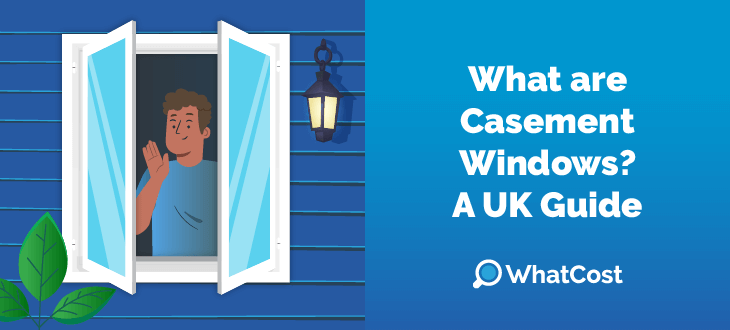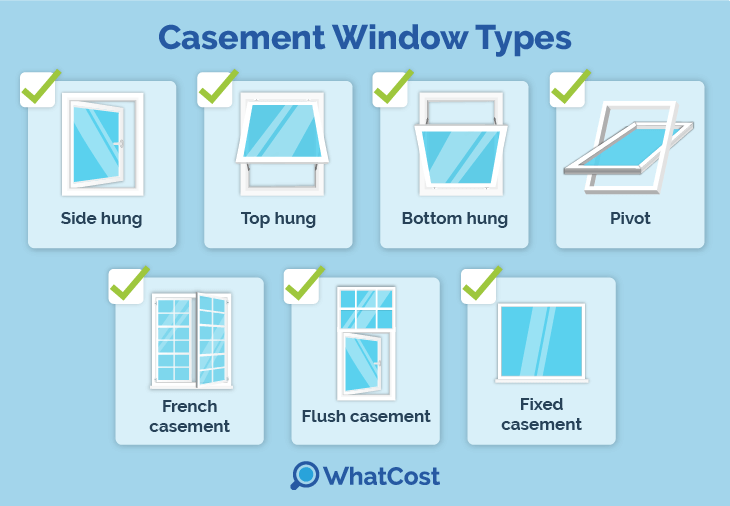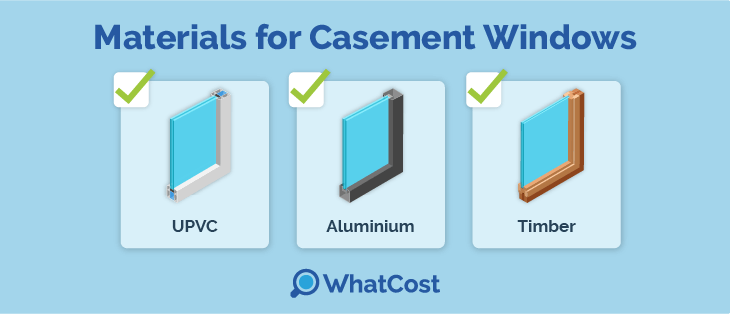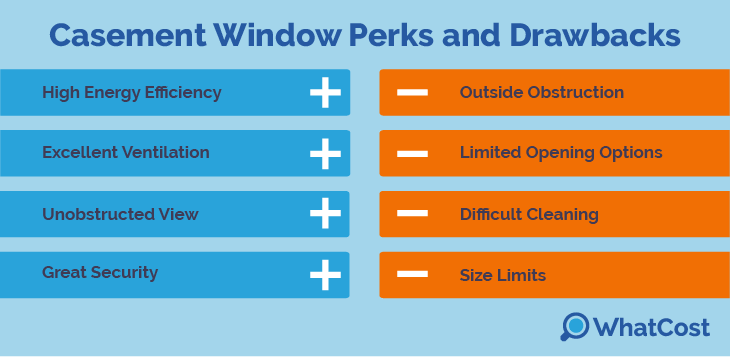Answer these simple questions and we will find you the BEST prices
Which type of solar quotes do you need?
It only takes 30 seconds
100% free with no obligation

Get up to 4 quotes by filling in only 1 quick form

Compare quotes and find yourself the best deal

Increase the value of your home by installing new windows
- whatcost.co.uk
- Windows
- Casement Windows
Casement Windows in the UK: Types, Costs, Pros & Cons


- A casement window can cost between £160 and £1,240, depending on the window size, frame material, installation complexity, and other consideration factors.
- There are many different casement window styles, the most common being standard side-hung windows, also available as top and bottom-hung windows. There are also more unique French casement and flush casement windows.
- Casement windows are usually made from three standard materials: UPVC, aluminium, and timber. Each material comes with unique properties, pros, and cons to consider.
Casement windows are the oldest and most prevalent style of windows in the UK, found in many homes, both old and new. Their sleek and minimal appearance makes them suitable for a wide range of homes while being some of the most affordable options on the market. Casement windows also come in a wide variety of stylistic and functional options, making them reliable for all sorts of homes.
This complete guide by WhatCost will delve into all things casement windows. Read on to learn about their various types, material composition, costs, pros and cons.
Ready to get a quote for windows? Let WhatCost land you the best bargain. Instead of spending countless hours researching and vetting installers, spend just 30 seconds filling out our online form. In return, we’ll send you 3 free home-tailored quotes from trusted professionals in your area. Click below to begin!
- Quotes from local installers
- Payment by finance available
- Save up to £150 per year
It only takes 30 seconds

What are casement windows?
Casement windows are some of the simplest, yet most versatile of window types. Found commonly across the UK, these windows are typically hinged at the side and fitted with double-glazed window panes. It’s also possible to find casement windows hinged at the top or bottom instead, as well as multiple other stylistic versions for different purposes.
Casement windows are often found in small to average window sizes because the entire glass pane swings outwards, making it inconvenient at larger sizes. However, it’s sometimes possible to find larger sizes, or even get them custom-made.
Casement windows cost in the UK
The cost of casement windows can range between £160 - £1,240, depending on multiple factors, but mainly on window size and chosen material frame. To help give you a better idea of your investment, here’s a look at the prices of casement windows:
| Window material | Cost (600 x 900mm) | Cost (900 x 1200mm) | Cost (1400 x 1400mm) |
| UPVC | £160 - £660 | £200 - £710 | £230 - £825 |
| Aluminium | £210 - £860 | £260 - £925 | £300 - £1,075 |
| Timber | £240 - £990 | £300 - £1,065 | £345 - £1,240 |
The costs are calculated including installation and the price of double-glazed windows, as per the requirements set by the UK Building Regulations.
Average window dimensions in the UK are usually around 600 x 900mm, but some may opt for larger windows in line with their home design. In addition, all windows need to have double-glazed window panes as per UK Building Regulations. Triple glazing windows as also an option for a higher cost, further improving thermal and noise insulation.
The cost of new windows installation is around £100 - £150 per window unit, with more complex jobs being on the higher end of the spectrum. We recommend consulting with a professional installer to make the most appropriate decision for your home.
In addition, window grants in the UK, such as the Energy Company Obligation (ECO4) and the Great British Insulation Scheme (GBIS), can provide partial or full cost coverage for double glazing, provided that you meet the qualifying criteria as a household.
Types of casement windows

There is a wide range of casement window types available on the market, each suited to a unique purpose and aesthetic. Being one of the most foundational window designs, casement windows are not just standalones, but also part of wider window projects such as bay and bow windows.
Here’s a summary of the main casement window types you can find:
- Side hung: These are the most common type of casement window, and are hinged at the sides to open horizontally, either inwards or outwards.
- Top hung: Sometimes called an awning window, these are hinged at the top and open outwards from the bottom, creating a ventilation gap without risking rain coming into the room. These are very suitable for wet climates.
- Bottom hung: Sometimes called a hopper window, these open from the top of the frame and are hinged at the bottom. This mechanism is also found in tilt and turn windows, and is ideal for apartments and ground floors due to the enhanced security.
- Pivot: These follow the same mechanism as the side hung or top/bottom hung windows, but instead of opening the standard way, they pivot horizontally or vertically to create a ventilation gap.
- French casement: French casement windows are two-panel casement windows that are both side-hinged. The windows meet at a central pillar or mullion where they lock and unlock with two handles. These windows open outwards to create a larger opening and provide better ventilation options.
- Flush casement: Flush casement windows can be distinguished from their minimalist frame and non-protruding window frame when closed, hence the name. This 19th-century design is timelessly modern and often found in an aluminium frame due to the sleek profile.
- Fixed casement: Sometimes called a picture window, this is a casement window that doesn’t open. Sometimes, these casement windows are part of a larger configuration, such as bay windows. Other times, larger picture windows are used to create.
With the wide array of casement window options available, choosing the right fit can seem like a daunting task. That’s why we recommend consulting with a professional installer who can help tailor the best course of action at the most affordable price.
Instead of spending hours surfing websites and scheduling phone calls, spend just 30 seconds filling out our online form and let WhatCost do the rest. We’ll connect you with up to 3 free home-tailored quotes from pre-vetted professionals in your area. Simply click below to begin!
- Quotes from local installers
- Payment by finance available
- Save up to £150 per year
It only takes 30 seconds

Casement window materials

Like most windows, casement windows are made from three key materials: UPVC, aluminium, and timber. Each material comes with its unique properties and costs to consider. In addition, there are pros and cons to either choice you make.
To help guide your decision, here’s a breakdown of what you could expect for each window frame material:
- UPVC: This synthetic plastic is a popular choice of window frame due to its affordable pricing, durability and thermal capacity. UPVC windows require little to no maintenance and are particularly resistant to weathering. The downside is that UPVC casement windows are not biodegradable like timber or as eco-friendly as aluminium.
- Aluminium: Aluminium casement windows have sleek and modern frames, often made slimmer than UPVC or timber, giving them a design edge. Aluminium windows are highly durable and exceptionally resistant to weathering and corrosion, making them both sustainable and reliable in the long term. The downside is that metal windows tend to cost much more than their UPVC or timber counterparts, but for good reason.
- Timber: Wooden windows will always be a classic, given their rustic charm that suits both traditional and modern homes. Timber is a natural insulator and can be decorated in endless stains and paint choices. The downside is that timber casement windows are the most susceptible to weathering and damage, requiring frequent maintenance over the years.
Materials such as aluminium and timber are often applauded for being more eco-friendly and hypoallergenic in the long run, while UPVC is known for its affordability and durability. There are also composite windows that combine UPVC and other polymers with materials such as wood.
Casement window glazing
Making sure that your window panes are thermally efficient is an important step in your window upgrade. UK Building Regulations expect windows to have secondary or double glazing at the very least to meet insulation requirements.
The cost of double glazed windows can be recuperated in just a few years, as A-rated secondary glazing can save you up to £140 on annual energy bills. Here’s a breakdown of the different window glazing options available:
- Secondary glazing: This is when an additional pane of glass or acrylic frame is installed directly inside your existing casement window, without needing new windows. Homes that wish to retain their antiques or are in conservation areas can benefit from secondary glazing, as it is less disruptive to the original frames. This approach works by creating a sealed air gap between the existing window pane and the new addition, which can reduce heat loss and noise pollution.
- Double glazing: This is the most common and preferred approach to windows in the UK, as recommended by the official UK Building Regulations. Double glazing consists of two glass panes with a sealed gap in between, typically filled with air or a gas like argon. This trapped space acts as a barrier of thermal and noise insulation.
- Triple glazing: While triple-glazed windows prices are higher (between 30% to 50% more than double glazing), it’s a great option for maximising thermal efficiency in your home. These feature three glass panes and two sealed gaps, filled with gas like argon or krypton that acts as an insulator. While costlier, triple glazing offers an unparalleled thermal and noise insulation, leading to lower U-values and higher savings.
To decide on the window glazing option best suited for you, we recommend consulting with a professional installer to devise a plan best suited to your needs.
Pros and cons of casement windows

Casement windows are a great choice for all types of homes, bringing with them a variety of types, colours, and designs to choose from. However, it’s important to assess the pros and cons that your decision can bring. Let’s start with the advantages of casement windows:
- High energy efficiency: Casement windows are designed to close with a near airtight seal. The sash of the casement window presses tightly against the frame in what’s called a compression seal. This helps ensure proper insulation, and when combined with double or triple-glazed windows, it can save you significantly on energy bills.
- Excellent ventilation: Unlike sash windows, casement windows open fully outwards from the home, providing a great source of ventilation for your house in comparison to other window types.
- Unobstructed view: Casement frames tend to be on the slimmer side as they don’t house any complex mechanisms inside the frame. This means you’ll have a larger glass area, offering an uninterrupted view of the outdoors.
- Great security: Casement windows often have crank handles and hook-shaped locks within the frame, creating a seal when closed that’s very difficult to get under and pry open from the outside. This helps enhance the security of your property.
However, it’s just as important to acknowledge and understand the potential downsides that come with casement windows when choosing an option for your home. Here’s a run-through of the potential cons you can expect to face with casement windows:
- Outside obstruction: The majority of casement windows swing outwards, which means they can interfere with any pathways, terraces or patios you may have outside, especially true for ground-floor casement windows.
- Limited opening options: Unlike tilt and turn windows, casement windows tend to only open one way. For horizontally opening casement windows, strong winds can pose a risk to the safety of your windows as they can be damaged by the force of the wind. Also, if you have an outdoor mosquito screen installed, then casement windows cannot open.
- Difficult cleaning: Since casement windows swing outwards, they can be a bit difficult to clean, or potentially hazardous if you are on higher floors of a building.
- Size limits: Since the casement window mechanism allows for the entire pane to swing outwards, larger, heavier windows would need more sturdy support, which becomes very impractical and costly for larger windows. Keep in mind, the larger the window, the bigger the scope of obstruction when it swings open.
When weighing the pros and cons of casement windows, you can make the choice best suited for you. However, it’s most recommended to get professional help in this process to determine the best course of action suited to your budget and needs. You may also be entitled to finance for windows via a UK grant scheme.
Should you get casement windows?
Casement windows are a wonderfully effective window option that is both affordable and versatile. It brings with it a wealth of benefits and can enhance your home's thermal efficiency, saving you on energy bills and reducing your carbon footprint.
However, deciding on getting casement windows is only the beginning of the journey. Finding a professional installer can often be a daunting task that requires strenuous research and vetting. Luckily, WhatCost can take care of the burden for you.
All it takes is 30 seconds to fill out our online form, and we’ll send you up to 4 free home-tailored quotes from our nationwide network of professional installers. No costs, no obligations. Simply click below to begin and let the bargains come to you!
- Quotes from local installers
- Payment by finance available
- Save up to £150 per year
It only takes 30 seconds

FAQ
Casement windows are a standard and popular window type, typically identified by being hinged on one side and opening horizontally. Some other variations of casement windows can also be top or bottom-hinged, opening vertically.
The key difference between regular and casement window types is that the latter has a window sash that opens entirely, swinging outside of the house. Regular windows tend to have limited opening capacity, with just sliding or lifting sashes.
The main difference between a casement and a sash window is their opening mechanisms. While a casement window is side-hinged and opens fully, sash windows work with a sliding mechanism, in which the window pane slides upwards or sideways and does not open outwards.
The best way to identify a casement window is by how it opens. Simply put, casement windows open like a door. They also often have a handle on the side and a lock mechanism that looks like a hook.
Casement window costs tend to be on the more affordable side when it comes to window types, costing around £160 – £1,240, depending on your window size, choice of framing material, and installation complexity.

Akif has a keen interest in green home improvement solutions and the role of digital media in identifying climate trends. He aims to provide a multidisciplinary approach to content rooted in credible research and accuracy.
